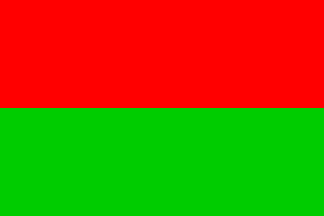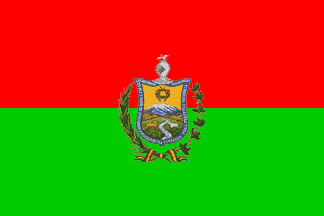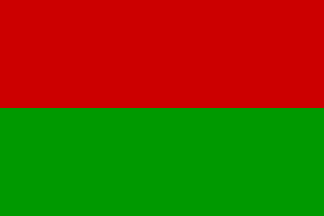
Last modified: 2020-12-26 by rob raeside
Keywords: la paz | error | coat of arms: mountain |
Links: FOTW homepage |
search |
disclaimer and copyright |
write us |
mirrors
 image by António Martins, 25 November 2006
image by António Martins, 25 November 2006
The flag of La Paz was hoisted for the first time on 31 July 1809 by
Victorio García Lanza during the Revolution of La Paz. Since then, the
flag was commonly used but was not given any legal status until 2 July
1987, when Prefect Ángel Gómez decreed that the official flag
of La Paz should be made of two equal horizontal stripes ponceau red and
emerald green.
Ivan Sache, 09 August 2006
The current La Paz department flag is the flag used
by the independentist Lanza Brothers, and for the Rebel
Army of the Charcas Audiency in the
Ayacucho Battle. Red is the blood of
the war (15 year war of independence) and green is the vegetation and the
hope. [m2nXX]
Jaume Ollé, 2 November 1996
Information on the flag is given in an article by the APG agency, released on 31 July 2006:
On 31 July 2006, the Fundación Ilimani organized in La Paz a civic parade involving some 500 children from the city. According to Raimy Pardo, Director of the foundation, the aim of the parade was to promote the Day of the Flag of La Paz and to inform the citizens that the colours of the flag are ponceau red (rojo punzó) and emerald green (verde esmeralda) and not guindo and green (verde) as they are often used by public and private institutions.The image attached to the article shows the flag with the coat of arms.
 image by António Martins, 25 November 2006
image by António Martins, 25 November 2006
Information on the flag is given in an article by the APG agency,
released on 31 July 2006. The image attached to the article shows the
flag with the coat of arms.
Ivan Sache, 09 August 2006
.gif) image by wikipedian José Nogales, 25 November 2006
image by wikipedian José Nogales, 25 November 2006
 image by António Martins, 25 November 2006
image by António Martins, 25 November 2006
Acording to Fundación Ilimani:
The colours of the flag are ponceau red (rojo punzó) and emerald green (verde esmeralda) and not guindo and green (verde) as they are often used by public and private institutions.Ivan Sache, 09 August 2006
At the
BoliviaMail
flag webstore, the flag of La Paz is described as «burgundy and
green» («guindo con verde»), while
Potosí and Oruro are said
to be «red» («rojo») — the image
on line
shows for each a shade of red undistinguishable from the other… and
dark greyish blue for the bottom, «green», stripe, while
Beni’s shade green in the same source is
quite common (and the national flag of yet a different
shade, but indisputably green).
António Martins, 22 June 2006
PPedro de la Gasca, to whom the Spanish king had entrusted rule over the former Inca lands, commanded Captain Alonso de Mendoza to found a new city commemorating the end of the civil wars in Peru. Then the city of La Paz was founded on October 20th, 1548 under the name of La Ciudad de Nuestra Señora de La Paz (The City of Our Lady of Peace). The city was first established in what today is Laja, on the Tiahuanaco road. Shortly after its founding, La Paz was moved to its present location, in the valley of the Chuquiago Marka.
On 1549, Juan Gutierrez Paniagua was commanded to design and urban plan that will designate sites for public areas, plazas, official buildings. La Plaza de los Españoles, what today constitutes the Plaza Murillo, was chosen as the location for government buildings as well as the cathedral.
Spain controlled La Paz with a firm grip and the Spanish king had the last word in all matters political. In 1781, for a total of six months, a group of a href="xi.html#aym?">Aymara people laid siege to the no longer peaceful city of La Paz. Under the leadership of Tupac Katari, they destroyed churches and government property. Thirty years later Indians laid a two-month siege on La Paz. In 1809 the struggle for independence from the Spanish rule brought uprisings against the royalist forces.
Today La Paz is a vibrant city, growing and expanding in all directions. La Paz has a population of more than a million inhabitants. La Paz is the official government site./p>
Ivan Sache,, 09 August 2006, quoting from BoliviaWeb.COM
On 16 July 1809, a well-prepared revolutionary insurrection bursted out
in La Paz. Around 7 PM, taking advantage of the procession of the
Carmen Virgin, the revolutionaries overthrew the Spanish Governor Tadeó
Dávila and Bishop Remigio de la Sánta y Ortega and set up a junta whose
leader and commander of the troops was the patriot Pedro Domingo
Murillo. On 27 July, the proclamation of the independence of the
colony, said to have been written by Priest Medina and the first
proclamation of that kind, was released and sent to the other main
cities of the colony, hoping they would support the uprising. The
revolutionaries decided to march against Chacaltaya in order to stop
the Spanish troops sent to suppress the insurrection. Pedro Indaburo
attempted a counter-coup, accusing Murillo of betrayal, but failed and
was executed by Antonio de Castro. The revolutionary troops were forced
to withdraw in the Yungas and were defeated in autumn during the
battles of Irupana and Chicaloma. Victorio García Lanza znd Castro
were executed after the battle. Murillo was captured in Zongo in early
December, as were soon the other leaders of the uprising. Since he had
been accused of negligence, Goyeneche, the commander of the Spanish
troops, exerted a very strong repression against the patriots. Some of
them were exiled to the Falkland Islands or the Philippines and their
goods were confiscated. On 29 January 1810, the nine so-called
Protomartyres of the Independence (Pedro Domingo Murillo, Juan Antbnio
Figueroa, Basilio Catacora, Apolinar Jáen, Buenaventura Bueno, Juán
Bautista Sagarnaga, Melchor Jiménez, Mariano Graneros and Gregorio
García Lanza) were sentenced to death and shot.
Ivan Sache, 09 Aug 2006, quoting from
Bolivian.COM
Here's a picture displaying the Mayor's Sash not only in a darker red, but
also in a darker green, as well as having the Sash divided vertically:
http://1.bp.blogspot.com, source:
http://musicbybolivia.blogspot.com/2010/07/la-alcaldia-de-la-paz-otorga-una.html
The Mayor's Sash is horizontally divided into two equal stripes (top red
and bottom green) ressembling the flag of La Paz displaying the coat of arms in
the middle, as seen here:
http://www.eldiario.net/noticias/2015/2015_06/nt150602/f_2015-06-02_44.jpg
For additional information go to La Paz (official website):
http://www.lapaz.bo/
Esteban Rivera, 26 July 2018